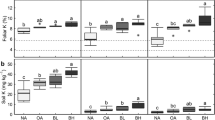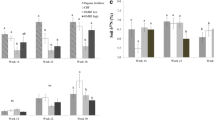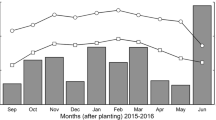Abstract
Purpose
Biochar has agronomic potential but currently is too expensive for widespread adoption. New methodologies are emerging to reduce the cost such as enriching biochar with nutrients that match crops and soil requirements. However, the effects of biochar-based fertilisers on plant yield and soil nutrient availability have not been widely examined. This study investigated the effects of a novel organo-mineral biochar fertiliser in comparison to organic and commercial biochar fertiliser on ginger (Zingiber officinale Canton).
Materials and methods
There were four treatments: (1) commercial organic fertiliser (5 t ha−1), as the control; (2) commercial biochar-based fertiliser (5 t ha−1); (3) organo-mineral biochar fertiliser at low rate (3 t ha−1); and (4) organo-mineral biochar fertiliser at high rate (7.5 t ha−1). A replicated pot trial was established with black dermosol soil and ten replicate pots for each treatment. Ginger was planted and grown for 30 weeks. Plant growth, biomass, foliar nutrients and water extractable soil nutrients including phosphorus (P), potassium (K) and calcium (Ca) were examined.
Results and discussion
High rate organo-mineral biochar fertiliser increased soil P and K availability at week 30 (harvest) after planting, compared to all other treatments and low rate organo-mineral biochar fertiliser performed similarly to the organic control for P and K. High rate organo-mineral biochar fertiliser increased total foliar nutrient content at week 30 in P, K and Ca compared to commercial biochar fertiliser. High rate organo-mineral biochar fertiliser improved the commercial value of ginger (+ 36%) due to a shift in the proportion of higher grade rhizomes. Low rate organo-mineral biochar fertiliser plants displayed similar yield, total dry and aboveground biomass to commercial organic fertiliser. Commercial biochar fertiliser had significantly lower biomass measures compared with other treatments as the rate applied had lower nutrient concentrations.
Conclusions
Our results show organo-mineral biochar fertilisers could be substituted for commercial organic fertilisers at low rates to maintain similar yield or applied at high rates to increase commercial value where economically feasible.






Similar content being viewed by others
References
Abiven S, Schmidt MWI, Lehmann J (2014) Biochar by design. Nat Geosci 7:326–327
Agegnehu G, Bass AM, Nelson PN, Muirhead B, Wright G, Bird MI (2015) Biochar and biochar-compost as soil amendments: effects on peanut yield, soil properties and greenhouse gas emissions in tropical North Queensland, Australia. Agric Ecosyst Environ 213:72–85
Aguilera E, Lassaletta L, Gattinger A, Gimeno BS (2013) Managing soil carbon for climate change mitigation and adaptation in Mediterranean cropping systems: a meta-analysis. Agric Ecosyst Environ 168:25–36
Akinwumi GS, Fariyike TA, Olufunmi OO, Olabode IA, Adelaja BA (2013) Influence of the rate and timing of mulching on the growth and yield of ginger (Zingiber officinale L.). In: Hannweg K, Penter M (eds) Proceedings of the second all Africa horticulture congress. Volume 1. ISHS Acta Horticulturae, South Africa, pp 323–328
Attoe EE, Osodeke VE (2009) Effects of NPK on growth and yield of ginger (Zingiber officinale Roscoe) in soils of contrasting parent materials of Cross River State. Elec J Environ Agric Food Chem 8:1261–1268
Bach M, Wilske B, Breuer L (2016) Current economic obstacles to biochar use in agriculture and climate change mitigation. Carbon Manag 7:183–190
Bai SH, Reverchon F, Xu C-Y, Xu Z, Blumfield TJ, Zhao H, Van Zwieten L, Wallace HM (2015a) Wood biochar increases nitrogen retention in field settings mainly through abiotic processes. Soil Biol Biochem 90:232–240
Bai SH, Xu C-Y, Xu Z, Blumfield TJ, Zhao H, Wallace HM, Reverchon F, Van Zwieten L (2015b) Soil and foliar nutrient and nitrogen isotope composition (δ15N) at 5 years after poultry litter and green waste biochar amendment in a macadamia orchard. Environ Sci Pollut Res 22:3803–3809
Bai SH, Xu C-Y, Xu Z, Blumfield TJ, Wallace HM, Walton D, Randall BW, Van Zwieten L (2016) Wood base biochar alters inorganic N. Acta Hortic (1109):151–154
Bai SH, Trueman SJ, Nevenimo T, Hannet G, Bapiwai P, Poienou M, Wallace HM (2017) Effects of shade-tree species and spacing on soil and leaf nutrient concentrations in cocoa plantations at 8 years after establishment. Agric Eco Env 246:134–143
Blackwell P, Krull E, Butler G, Herbert A, Solaiman Z (2010) Effect of banded biochar on dryland wheat production and fertiliser use in south-western Australia: an agronomic and economic perspective. Aust J Soil Res 48:531–545
Blackwell P, Joseph S, Munroe P, Anawar HM, Storer P, Gilkes RJ, Solaiman ZM (2015) Influences of biochar and biochar-mineral complex on mycorrhizal colonisation and nutrition of wheat and sorghum. Pedosphere 25:686–695
Camacho HE, Brescia A (2009) The Australian ginger industry—overview of market trends and opportunities. Australian Ginger Growers Association, Brisbane. https://www.daf.qld.gov.au/__data/assets/pdf_file/0006/74895/Australian-ginger-industry-report.pdf. Accessed 6 February 2018
Chan KY, Van Zwieten L, Meszaros I, Downie A, Joseph S (2007) Agronomic values of greenwaste biochar as a soil amendment. Aust J Soil Res 45:629–634
Chan KY, Van Zwieten L, Meszaros I, Downie A, Joseph S (2008) Using poultry litter biochars as soil amendments. Aust J Soil Res 46:437–444
Cheng CH, Lehmann J, Thies JE, Burton SD, Engelhard MH (2006) Oxidation of black carbon by biotic and abiotic processes. Org Geochem 37:1477–1488
Chia CH, Singh BP, Joseph S, Graber ER, Munroe P (2014) Characterization of an enriched biochar. J Anal Appl Pyrolysis 108:26–34
Darby I, Xu C-Y, Wallace HM, Joseph S, Pace B, Bai SH (2016) Short-term dynamics of carbon and nitrogen using compost, compost-biochar mixture and organo-mineral biochar. Environ Sci Pollut Res 23:11267–11278
DeLuca TH, MacKenzie MD, Gundale MJ (2009) Biochar effects on soil nutrient transformations. In: Lehmann J, Joseph S (eds) Biochar for environmental management: science and technology. Earthscan Publications, London, pp 251–270
Dinesh R, Srinivasan V, Hamza S, Manjusha A, Sanjay Kumar P (2012) Short-term effects of nutrient management regimes on biochemical and microbial properties in soils under rainfed ginger (Zingiber officinale Rosc.). Geoderma 173-174:192–198
Drake JA, Carrucan A, Jackson WR, Cavagnaro TR, Patti AF (2015) Biochar application during reforestation alters species present and soil chemistry. Sci Total Environ 514:359–365
Glaser B, Wiedner K, Seelig S, Schmidt HP, Gerber H (2015) Biochar organic fertilizers from natural resources as substitute for mineral fertilizers. Agron Sustain Dev 35:667–678
Godfray HCJ, Beddington JR, Crute IR, Haddad L, Lawrence D, Muir JF, Pretty J, Robinson S, Thomas SM, Toulmin C (2010) Food security: the challenge of feeding 9 billion people. Science 327:812–818
Halder NK, Shill NC, Siddiky MA, Gomes R, Sarkar J (2007) Response of ginger to zinc and boron fertilization. Asian J Plant Sci 6:394–398
Hammond J, Shackley S, Prendergast-Miller M, Cook J, Buckingham S, Pappa VA (2013) Biochar field testing in the UK: outcomes and implications for use. Carbon Manag 4:159–170
He Y, Zhou X, Jiang L, Li M, Du Z, Zhou G, Shao J, Wang X, Xu Z, Bai SH, Wallace H, Xu C-Y (2017) Effects of biochar application on soil greenhouse gas fluxes: a meta-analysis. GCB Bioenergy 9:743–755
Joseph SD, Camps-Arbestain M, Lin Y, Munroe P, Chia CH, Hook J, Van Zwieten L, Kimber S, Cowie A, Singh BP, Lehmann J, Foidl N, Smernik RJ, Amonette JE (2010) An investigation into the reactions of biochar in soil. Aust J Soil Res 48:501–515
Joseph S, Graber ER, Chia C, Munroe P, Donne S, Thomas T, Nielsen S, Marjo C, Rutlidge H, Pan GX, Li L, Taylor P, Rawal A, Hook J (2013) Shifting paradigms: development of high-efficiency biochar fertilizers based on nano-structures and soluble components. Carbon Manag 4:323–343
Joseph S, Anawar HM, Storer P, Blackwell P, Chia C, Lin Y, Munroe P, Donne S, Horvat J, Wang J, Solaiman ZM (2015a) Effects of enriched biochars containing magnetic iron nanoparticles on mycorrhizal colonisation, plant growth, nutrient uptake and soil quality improvement. Pedosphere 25:749–760
Joseph S, Husson O, Graber E, Van Zwieten L, Taherymoosavi S, Thomas T, Nielsen S, Ye J, Pan GX, Chia C, Munroe P, Allen J, Lin Y, Fan X, Donne S (2015b) The electrochemical properties of biochars and how they affect soil redox properties and processes. Agron J 5:322–340
Jung KW, Kim K, Jeong TU, Ahn KH (2016) Influence of pyrolysis temperature on characteristics and phosphate adsorption capability of biochar derived from waste-marine macroalgae (Undaria pinnatifida roots). Bioresour Technol 200:1024–1028
Kim P, Hensley D, Labbé N (2014) Nutrient release from switchgrass-derived biochar pellets embedded with fertilizers. Geoderma 232-234:341–351
Lægreid M, Bockman OC, Kaarstad O (1999) Agriculture, fertilizers and the environment. CABI Publishing, New York
Lal R (2009) Soils and food sufficiency. A review. Agron Sustain Dev 29:113–133
Lehmann J (2007) Bio-energy in the black. Front Ecol Environ 5:381–387
Lehmann J, da Silva JP Jr, Steiner C, Nehls T, Zech W, Glaser B (2003) Nutrient availability and leaching in an archaeological Anthrosol and a Ferralsol of the Central Amazon basin: fertilizer, manure and charcoal amendments. Plant Soil 249:343–357
Lehmann J, Rillig MC, Thies J, Masiello CA, Hockaday WC, Crowley D (2011) Biochar effects on soil biota—a review. Soil Biol Biochem 43:1812–1836
Lin Y, Munroe P, Joseph S, Kimber S, van Zwieten L (2012) Nanoscale organo-mineral reactions of biochars in a ferrosol: an investigation using microscopy. Plant Soil 357:369–380
Lin Y, Munroe P, Joseph S, Ziolkowski A, van Zwieten L, Kimber S, Rust J (2013) Chemical and structural analysis of enhanced biochars: thermally treated mixtures of biochar, chicken litter, clay and minerals. Chemosphere 91:35–40
Liu Y, Pan X, Li J (2015) Current agricultural practices threaten future global food production. J Agric Environ Ethics 28:203–216
Majumdar B, Venkatesh MS, Kumar K, Patiram (2005) Effect of potassium and farmyard manure on yield, nutrient uptake and quality of ginger (Zingiber officinale) in a Typic Hapludalf of Meghalaya. Indian J Agric Sci 75:809–811
McDonald RC, Isbell RF, Speight JG, Walker J, Hopkins MS (1990) Australian soil and land survey field handbook. Inkata Press, Melbourne
Mehmood K, Li JY, Jiang J, Masud MM, Xu RK (2015) Effect of low energy-consuming biochars in combination with nitrate fertilizer on soil acidity amelioration and maize growth. J Soils Sed 17:790–799
Morales VL, Pérez-Reche FJ, Hapca SM, Hanley KL, Lehmann J, Zhang W (2015) Reverse engineering of biochar. Bioresour Technol 183:163–174
Mueller ND, Gerber JS, Johnston M, Ray DK, Ramankutty N, Foley JA (2012) Closing yield gaps through nutrient and water management. Nature 490:254–257
Nair KP (2013) The agronomy and economy of turmeric and ginger. Elsevier, London
Nelissen V, Ruysschaert G, Manka'Abusi D, D'Hose T, De Beuf K, Al-Barri B, Cornelis W, Boeckx P (2015) Impact of a woody biochar on properties of a sandy loam soil and spring barley during a two-year field experiment. Eur J Agron 62:65–78
Nguyen TTN, Wallace HM, Xu C-Y, Xu Z, Farrar MB, Joseph S, Van Zwieten L, Bai SH (2017a) Short-term effects of organo-mineral biochar and organic fertilisers on nitrogen cycling, plant photosynthesis, and nitrogen use efficiency. J Soils Sediments 17:2763–2774
Nguyen TTN, Xu C-Y, Tahmasbian I, Che R, Xu Z, Zhou X, Wallace HM, Bai SH (2017b) Effects of biochar on soil available inorganic nitrogen: a review and meta-analysis. Geoderma 288:79–96
Nguyen TTN, Wallace HM, Xu C-Y, Zwieten L, Weng ZH, Xu Z, Che R, Tahmasbian I, Hu H-W, Bai SH (2018) The effects of short term, long term and reapplication of biochar on soil bacteria. Sci Total Environ 636:142–151
Nielsen S, Minchin T, Kimber S, van Zwieten L, Caporaso G, Gilbert J, Munroe P, Joseph S, Thomas T (2014) Enhanced biochar causes complex shifts in soil microbial communities. Agric Ecosys Environ 191:73–82
Olmo M, Villar R, Salazar P, Alburquerque JA (2016) Changes in soil nutrient availability explain biochar’s impact on wheat root development. Plant Soil 399:333–343
Reverchon F, Flicker RC, Yang H, Yan G, Xu Z, Chen C, Bai SH, Zhang D (2014) Changes in δ15N in a soil–plant system under different biochar feedstocks and application rates. Biol Fert Soils 50:275–283
Rickson RJ, Deeks LK, Graves A, Harris JAH, Kibblewhite MG, Sakrabani R (2015) Input constraints to food production: the impact of soil degradation. Food Secur 7:351–364
Sarfraz R, Shakoor A, Abdullah M, Arooj A, Hussain A, Xing S (2017) Impact of integrated application of biochar and nitrogen fertilizers on maize growth and nitrogen recovery in alkaline calcareous soil. Soil Sci Plant Nutr 63:488–498
Schachtman DP, Reid RJ, Ayling SM (1998) Phosphorus uptake by plants: from soil to cell. Plant Physiol 116:447–453
Seyie A, Naruka IS, Singh PP, Kushwah SS (2013) Nutrient management and its effect on growth, yield and quality of ginger cultivars. Indian J Hortic 70:65–70
Smith M, Hamill S (1996) Field evaluation of micropropagated and conventionally propagated ginger in subtropical Queensland. Aust J Exp Agric 36:347–354
Sohi SP, Krull E, Lopez-Capel E, Bol R (2010) A review of biochar and its use and function in soil. In: Sparks DL (ed) Advances in agronomy, Volume 105. Elsevier Science Publishing, London, pp 47–82
Spokas KA, Cantrell KB, Novak JM, Archer DW, Ippolito JA, Collins HP, Boateng AA, Lima IM, Lamb MC, McAloon AJ, Lentz RD, Nichols KA (2012) Biochar: a synthesis of its agronomic impact beyond carbon sequestration. J Environ Qual 41:973–989
Steiner C, Teixeira WG, Lehmann J, Nehls T, De Macêdo JLV, Blum WEH, Zech W (2007) Long term effects of manure, charcoal and mineral fertilization on crop production and fertility on a highly weathered Central Amazonian upland soil. Plant Soil 291:275–290
Taghizadeh-Toosi A, Clough TJ, Sherlock RR, Condron LM (2012) Biochar adsorbed ammonia is bioavailable. Plant Soil 350:57–69
Tavakkoli E, Fatehi F, Coventry S, Rengasamy P, McDonald GK (2010) Additive effects of Na+ and Cl- ions on barley growth under salinity stress. J Exp Biol 62:2189–2203
Tilman D, Balzer C, Hill J, Befort BL (2011) Global food demand and the sustainable intensification of agriculture. Proc Natl Acad Sci 108:20260–20264
United Nations (2017) World population prospects: the 2017 revision, key findings and advance tables. https://www.un.org/development/desa/publications/world-population-prospects-the-2017-revision.html. Accessed 6 February 2018
Vaccari FP, Maienza A, Miglietta F, Baronti S, Di Lonardo S, Giagnoni L, Lagomarsino A, Pozzi A, Pusceddu E, Ranieri R, Valboa G, Genesio L (2015) Biochar stimulates plant growth but not fruit yield of processing tomato in a fertile soil. Agric Ecosyst Environ 207:163–170
van Zwieten L, Kimber S, Morris S, Chan KY, Downie A, Rust J, Joseph S, Cowie A (2010) Effects of biochar from slow pyrolysis of papermill waste on agronomic performance and soil fertility. Plant Soil 327:235–246
Venkat K (2012) Comparison of twelve organic and conventional farming systems: a life cycle greenhouse gas emissions perspective. J Sustain Agric 36:620–649
Vochozka M, Marouskova A, Vachal J, Strakova J (2016) Biochar pricing hampers biochar farming. Clean Techn Environ Policy 18:1225–1231
Wang T, Camps-Arbestain M, Hedley M, Bishop P (2012) Predicting phosphorus bioavailability from high-ash biochars. Plant Soil 357:173–187
Xu C-Y, Bai SH, Hao Y, Rachaputi RCN, Wang H, Xu Z, Wallace H (2015a) Effect of biochar amendment on yield and photosynthesis of peanut on two types of soils. Environ Sci Pollut Res 22:6112–6125
Xu C-Y, Bai SH, Hao Y, Rachaputi RCN, Xu Z, Wallace HM (2015b) Peanut shell biochar improves soil properties and peanut kernel quality on a red Ferrosol. J Soils Sediments 15:2220–2231
Yao C, Joseph S, Li L, Pan G, Lin Y, Munroe P, Pace B, Taherymoosavi S, Van Zwieten L, Thomas T, Nielsen S, Ye J, Donne S (2015) Developing more effective enhanced biochar fertilisers for improvement of pepper yield and quality. Pedosphere 25:703–712
Ye J, Zhang R, Nielsen S, Joseph SD, Huang D, Thomas T (2016) A combination of biochar–mineral complexes and compost improves soil bacterial processes, soil quality, and plant properties. Front Microbiol 7:1–13
Zarcinas BA, Cartwright B, Spouncer L (1987) Nitric acid digestion and multi-element analysis of plant material by inductively coupled plasma spectrometry. Commun Soil Sci Plant Anal 18:131–146
Zhang D, Pan G, Wu G, Kibue GW, Li L, Zhang X, Zheng J, Zheng J, Cheng K, Joseph S, Liu X (2016) Biochar helps enhance maize productivity and reduce greenhouse gas emissions under balanced fertilization in a rainfed low fertility inceptisol. Chemosphere 142:106–113
Zhao X, Wang J, Wang S, Xing G (2014) Successive straw biochar application as a strategy to sequester carbon and improve fertility: a pot experiment with two rice/wheat rotations in paddy soil. Plant Soil 378:279–294
Zheng J, Han J, Liu Z, Xia W, Zhang X, Li L, Liu X, Bian R, Cheng K, Zheng J, Pan G (2017) Biochar compound fertilizer increases nitrogen productivity and economic benefits but decreases carbon emission of maize production. Agric Ecosyst Environ 241:70–78
Acknowledgements
MF was supported by Honours funding at University of the Sunshine Coast to undertake this study. This study was supported with Seed Funding from University of the Sunshine Coast (USC/CRN2012/03) and Griffith University (EFC-JRE). SHB and CYX were research fellows supported by Collaborative Research Network, University of the Sunshine Coast Research Futures project (CRN2011:08). The authors would like to acknowledge Mr. Murray Elks for the donation of poultry litter, Mr. Geoffrey Lambert and Mr. Scott Byrnes for assistance with laboratory analysis, Mrs. Emma Farrar, Mr. Bruce Randall, Dr. David Walton, Mr. Ross McIntosh, Mr. Ian Darby, Mr. Chris Taylor and Mrs. April Gray for assistance in field work and Dr. Peter K. Dunn for statistical analysis guidance.
Author information
Authors and Affiliations
Corresponding author
Additional information
Responsible editor: Hialong Wang
Electronic supplementary material
ESM 1
(DOCX 65 kb)
Rights and permissions
About this article
Cite this article
Farrar, M.B., Wallace, H.M., Xu, CY. et al. Short-term effects of organo-mineral enriched biochar fertiliser on ginger yield and nutrient cycling. J Soils Sediments 19, 668–682 (2019). https://doi.org/10.1007/s11368-018-2061-9
Received:
Accepted:
Published:
Issue Date:
DOI: https://doi.org/10.1007/s11368-018-2061-9




